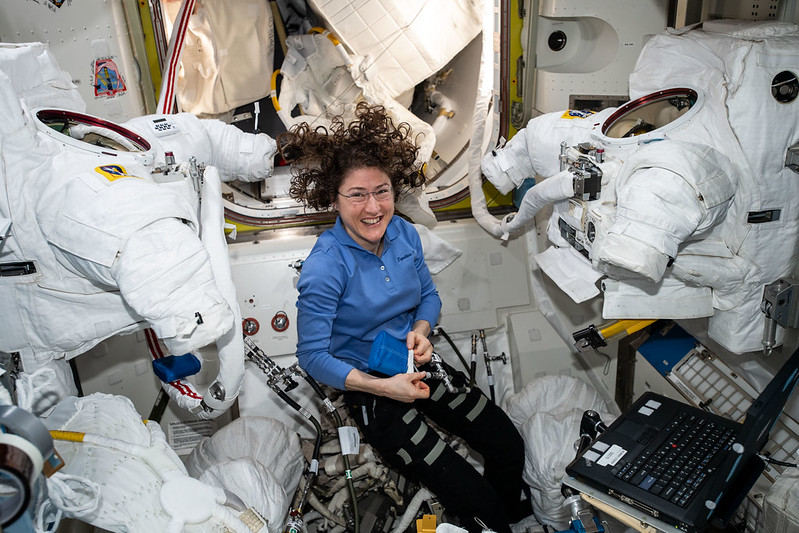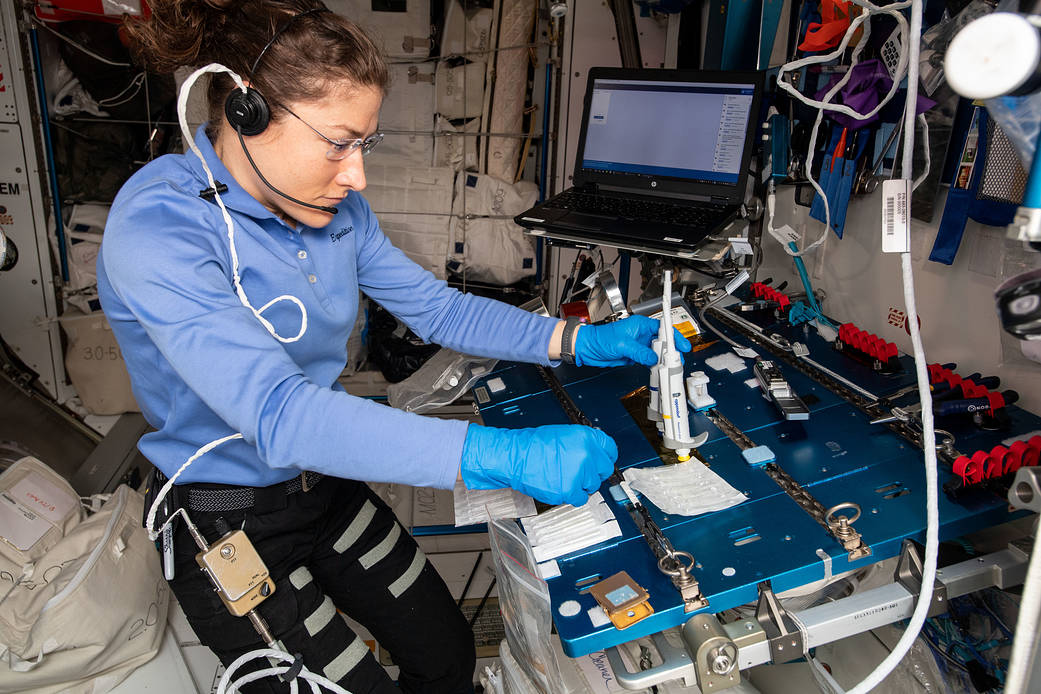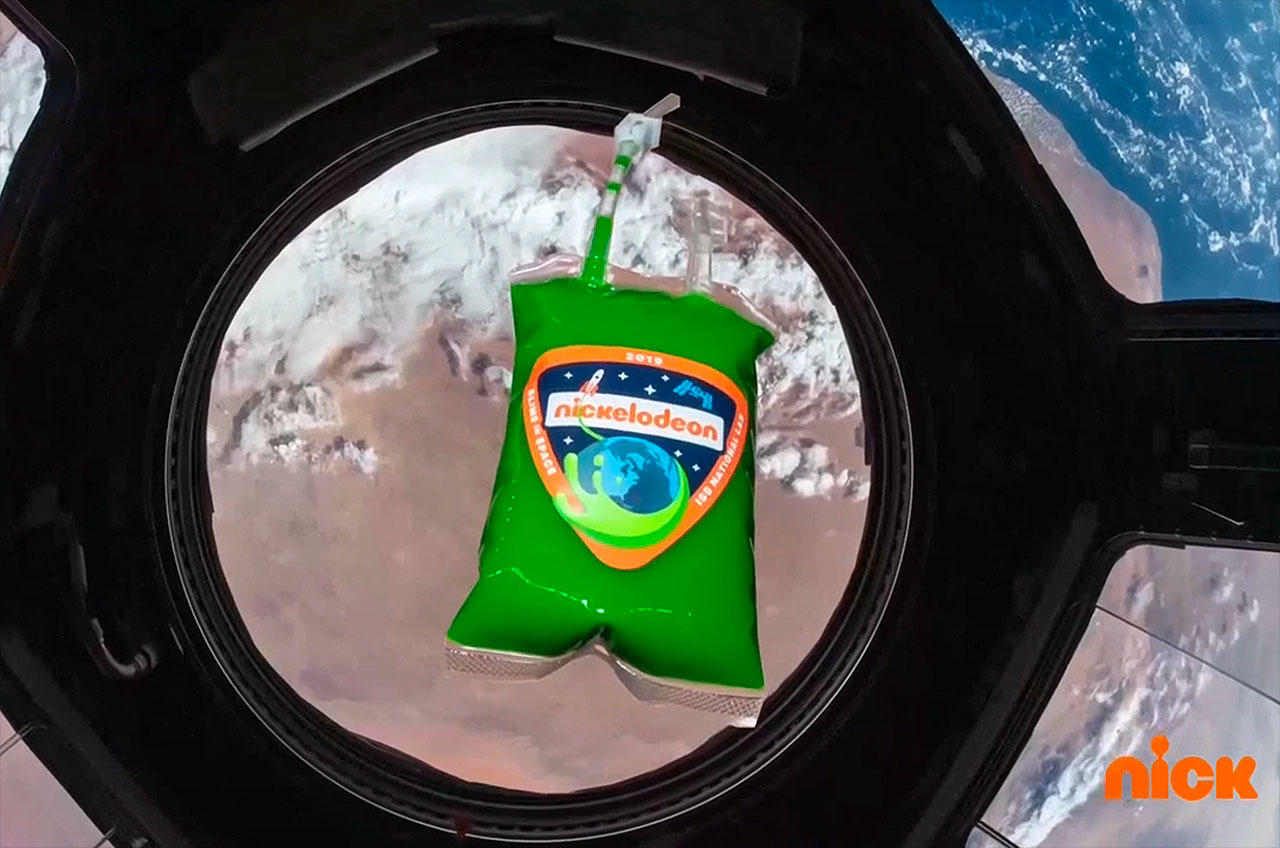NASA astronaut Christina Koch is breaking records and inspiring the next generation

CAPE CANAVERAL, Fla. — Record-setting NASA astronaut Christina Koch is continuing her mission to inspire the next generation of explorers.
As part of a long-duration mission, Christina Koch spent 328 days in space, marking the longest single spaceflight by a woman, and the second-longest after fellow NASA astronaut, Scott Kelly. While aboard the International Space Station (ISS), Koch participated in a variety of research investigations, including some student-run experiments. She spoke to Space.com about inspiring young people and how important it is to engage with kids through these types of experiments.
"In addition to the science we bring back to Earth, and the exploration and discovery, STEM education and inspiration is really important and has such a positive impact," Koch told Space.com. "I think this is one of the biggest reasons why it's so important to have a human spaceflight program."
Related: The 1st all-woman spacewalk: photos, videos and tweets
Genes in space
Koch is a big proponent of inspiring the next generation of scientists and explorers and, as such, participated in a few key STEM (science, technology, engineering and mathematics) activities while in space. One such activity was a series of student-designed experiments called Genes in Space.
Sponsored by Boeing, the Genes in Space research program is a nationwide contest for students in grades 7-12 that challenges students to design an experiment using DNA to address a real problem in spaceflight. The winning student's experiment then gets to fly on the space station.
"Being in space was awesome. I was on board [the ISS] for about 11 months, and with our main mission being science I was super excited to help with the research," Koch told Space.com. "I have a couple of experiments that stand out in my mind as being memorable for various reasons and the genes and space is definitely one of them."
Breaking space news, the latest updates on rocket launches, skywatching events and more!
Koch participated in the Genes in Space-6 experiment, which was the first-ever to use CRISPR technology in space, with is a novel gene editing tool. As part of the experiment, yeast DNA was cut across both strands, creating significant damage. Researchers then analyzed how the yeast repaired itself.
One drawback to spaceflight is that space radiation can potentially damage human DNA. On Earth, the body can repair itself by adding or deleting DNA bases, or even rejoining the piece without altering them. However, this has not been studied in microgravity until now.
Koch shared that she was really excited to be working on this experiment as she was "kind of a geek about CRISPR" going into her spaceflight.
"That particular science breakthrough was really exciting, so I did seek out a lot of extra info on it," she said. "I learned about the students that designed it, I learned about the science itself because I just kind of wanted to have that in the back of my mind as I was following the steps, doing the actual lab work on the bench."
While on the station, astronauts typically work on hundreds of experiments so, according to Koch, they don't typically get the opportunity to learn about any given experiment that far in advance. "We really just try to be good at figuring out something quickly on the fly and being successful in the period of time we have," she said. "So that the scientists can get the maximum science out of it."
During more hands-on experiments, like Genes in Space-6, Koch said that the astronauts work with researchers on the ground via a headset. "An investigator talks to you on a headset the whole time that you're doing the experiment, and guides you through it," she said. "They want to have real-time feedback with you (for the more complicated experiments) so there was a camera set up where they could see what I was doing."
"It was really like working with your partner in the lab, only this time we're separated by 250 miles of space," she said.
She also explained that one of the fun things about working in microgravity is that liquids and pipettes don't always work as they do on Earth, so the team had to work through some unexpected issues.
Nickelodeon slime
One of the other big STEM-related activities that Christina took part in while living and working in space was playing with slime]. In 2020, Nickelodeon's famous slime was blasted into space as part of a project aimed at getting kids around the world interested in STEM.
Koch said that the slime was a lot of fun. "I grew up watching slime on TV, and I never thought that that would be a first in my life, but doing slime in space is definitely one of the highlights of my flight," she said.
"We had a lot of fun with it, so I hope the kids did too," she said. "Benefits of space activities come in many different forms — some are purely scientific, maybe technical, and some are hopefully inspirational, so it's important that we cover the full spectrum to maximize the good that we do up here."
Koch added that the slime was used to help kids be more cognizant not only of human spaceflight but also of how things work in microgravity.
"The perspective that everything we look around and see is normal, really is only normal because it's what we're used to, but when you see blobs of slime floating in space and doing strange things, you know that's normal in microgravity," she said.
One of the surprising things about slime was how very differently it behaved from water in space. "When you work with water in space, you have to be really careful that its surface tension doesn't change when it comes in contact with something because it doesn't really like to stall in a ball," Koch said.
"Slime, on the other hand, likes to stay as a blob, and you can even bat it around, which was really fun."
Koch said that both of the substances have their applications, and she hopes the kids had as much fun with it as she did.
Future impacts
One of Koch's favorite activities is engaging with kids, and she says the response she gets from them is always interesting.
"My favorite reaction from students is actually when they're very underwhelmed because to me, it shows that in their world, spaceflight is so normal that they're unimpressed by it," she said.
Koch says that students are a great example of how diverse backgrounds support innovative thoughts and ideas, which the space industry needs. She added that engaging with a diverse variety of students and kids is a great way to ensure that we have the engineers, scientists and astronauts of the future.
Programs like Genes in Space are a great way to grab students' attention. Kristoff Misquitta is one of those students. He is the current winner of the contest and his experiment, Genes in Space-8 is up on the space station right now.
Misquitta said that winning the contest is a very surreal experience. "I see the space station flying overhead at night, and it looks like a far-off star, and the fact that my work is on the ISS just blows my mind," he told Space.com. "I think that's a testament to how accessible science has become."
"I think this program, and my experiment, are part of a larger trend in space that's making science and just space concepts, in general, more accessible to the public, and it makes me really excited," he added.
Misquitta said that he learned about the Genes in Space contest through one of the teachers in his high school, and it sounded like a fun idea. He was looking for space-related opportunities for students to see if aerospace engineering was for him. That's when he found out about the challenge.
"This [contest] came at a pretty formative time for me," he said. "It was my junior year of high school and so that was the point where I was kind of considering applying to college and then what I would pursue in college."
"Thanks to the help and mentorship I received throughout the Genes in Space contest, I'm now at MIT hoping to study aerospace engineering, ideally on the space side" he added. "The experience helped solidify my major."
Misquitta says he hopes that sometime in the future he will be able to follow up on his experiment, which he said has helped him lay the foundations for his future career.
"It's not just me, other students are going to be able to do so as well through genes and space and other opportunities in the future," he said. "So, I'm really optimistic about it."
Misquitta said that as part of the program, students are matched with mentors at ivy league schools in the Boston area, like Harvard and MIT. He added that having access to those mentors is really pivotal not only for the experiment the student is trying to develop but also for their future.
Dr. Katy Martin, program lead for the Genes in Space program, says that the students have to submit a proposal much like a grant application, so it helps to teach them valuable skills. Each student is matched with a mentor, who is an actual scientist, and they really spend a lot of time with them refining the proposals. "Even if they don't win the contest, this is an invaluable experiment for the students," Martin told Space.com.
"Our one winner is chosen by a team of judges, and we're looking for both the scientific merit as well as a student who can represent the competition as a whole, and be a role model to other students who are thinking about getting involved in sciences and engineering and our competition as well," Martin said. "Kristoff is a great example of that."
Misquitta said that NASA astronaut Megan McArthur conducted his experiment on the space station. He said that he didn't have any direct interaction with her while she was in space but did get to follow along on how the experiment was progressing via the folks at the ISS National lab.
Koch says that the astronauts typically communicate directly with trained researchers, so she didn't have any direct interaction with the students that designed the experiment she worked on, but did say she was able to chat with them after returning to Earth.
Making space for girls
NASA's next big human spaceflight program is the Artemis program. Koch is one of eighteen astronauts named to the program, which plans to land the first woman and the next man on the Moon before the end of this decade. The program also aims to land the first person of color on the moon.
There is quite a lot to do before mission assignments are doled out, but Koch is excited about what Artemis means for all of humanity.
"To me, what the mission really represents is that NASA is committed to answering humanity’s call to explore," she said. "We're an example of how you’re most successful when you take contributions from every single part of the world, and the planet, and humanity. I’m just really proud to be a part of it."
And diversity is a big part of that. Koch took part in the first all-woman spacewalk in history, alongside fellow NASA astronaut Jessica Meir, during her time in space
In order to make sure that NASA and the United States stays at the forefront of innovation, Koch says that it's important to use the space station to help inspire and encourage young people to pursue STEM-related fields.
One way to do that is by partnering with companies like Nickelodeon that bring space station science back to the classroom. Another way is via agencies like the Girl Scouts, for example, which is partnering with NASA to develop a program that encourages its young members to think about and spark an interest in space.
This summer, the Girl Scouts sent three different experiments to the space station aboard a SpaceX Cargo Dragon mission. One of these missions could help shed light on how plants grow in microgravity, while the other two experiments involved ants and brine shrimp. "Tomato seeds, pepper seeds, and lemongrass seeds were chosen because they're good sources of renewable energy, food, and medicine," Jordan Dean, a member of Troop 7192, told Space.com.
Dean is one of the winners who helped design the plant growth experiment. She said she came up with this experiment "because it could be very useful for future space travelers and astronauts, and so that we can inspire other girls to do things like this."
Koch said that getting girls to stick with STEM programs throughout their schooling is important. And that hopefully, these types of programs are beneficial to that goal.
"If our country is just gonna stay on the forefront of leading innovation, leading solving some of the world's biggest problems we have to make sure that we recruit and retain people to study these tough fields and to recognize that when you do commit to that that there are awesome things you can do with it and that those things can really make a difference," she said.
In addition to her duties as an astronaut, Koch says she is able to keep up with and continue to connect with students. "It's been mostly virtual but we engage a lot with students, both through a lot of different age ranges, both in classroom situations [and] award ceremonies, a lot of different engagement so to me that's one of the greatest things about this job and about the opportunity," she said.
To Koch, living in space was not only a chance to inspire others but also a dream come true.
"I think, overall, flying in space is the dream job: you get to be in a place where you have this amazing perspective on Earth; you get to, you know, carry everyone's dreams with you in space; hopefully inspire people, and then your day-to-day is doing science and maintenance, " she told Space.com. "And I can't imagine a better job than that."
Follow Amy Thompson on Twitter @astrogingersnap. Follow us on Twitter @Spacedotcom or Facebook.

Amy Thompson is a Florida-based space and science journalist, who joined Space.com as a contributing writer in 2015. She's passionate about all things space and is a huge science and science-fiction geek. Star Wars is her favorite fandom, with that sassy little droid, R2D2 being her favorite. She studied science at the University of Florida, earning a degree in microbiology. Her work has also been published in Newsweek, VICE, Smithsonian, and many more. Now she chases rockets, writing about launches, commercial space, space station science, and everything in between.



